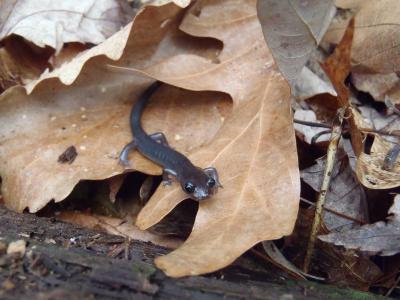Wild salamanders living in some of North America’s best salamander habitat are getting smaller as their surroundings get warmer and drier, forcing them to burn more energy in a changing climate.
That’s the key finding of a new study co-authored by a Clemson University biologist and published Tuesday in the journal Global Change Biology that examined museum specimens caught in the Appalachian Mountains from 1957 to 2007 and wild salamanders measured at the same sites in 2011-2012.
The salamanders studied from 1980 onward were, on average, eight percent smaller than their counterparts from earlier decades. The changes were most marked in the Southern Appalachians and at low elevations, settings where detailed weather records showed the climate has warmed and dried out most.
“One of the stresses that warmer climates will impose on many organisms is warmer body temperatures,” said Michael W. Sears of the biological sciences department. “These warmer body temperatures cause animals to burn more energy while performing their normal activities. All else being equal, this means that there is less energy for growth.”
To find out how climate change affected the animals, Sears used a computer program to create an artificial salamander, which allowed him to estimate a typical salamander’s daily activity and the number of calories it burned.
Using detailed weather records for the study sites, Sears was able to simulate the minute-by-minute behavior of individual salamanders based on weather conditions at their home sites during their lifetimes. The simulation showed that modern salamanders were just as active as their ancestors had been.
“Ectothermic organisms, such as salamanders, cannot produce their own body heat,” Sears explained. “Their metabolism speeds up as temperatures rise, causing a salamander to burn seven to eight percent more energy in order to maintain the same activity as their forebears.”
The changing body size of salamanders is one of the largest and fastest rates of change ever recorded in any animal and the data recorded in this study reveals that it is clearly correlated with climate change, according to Karen R. Lips, associate professor at the University of Maryland’s (UMD) department of biology and co-author on the paper.
“We do not know if decreased body size is a genetic change or a sign that the animals are flexible enough to adjust to new conditions,” said Lips. “If these animals are adjusting, it gives us hope that some species are going to be able to keep up with climate change.”
The research team’s next step will be to compare the salamander species that are getting smaller to the ones that are disappearing from parts of their range. If they match, the team will be one step closer to understanding why salamanders are declining in a part of the world that once was a haven for them.


I found that the content of this blog is incredibly valuable and delivers a wealth of information. It creates a large amount of realisation and awareness towards the effects of climate change on living organisms. Research is still being conducted to determine if the shrinking in salamanders are due to genetic change or climate change, however, the fact that climate change could be a possibilty, it is therefore of utmost importance we consider it has a contributing factor. Although the above speaks of just the salamanders, It has caused me to think about all the other living organisms that are possibly becomming victims of climate changes. If climate change is an influencing factor and the salamanders are actaully able to adapt by altering their internal environment to suit the changes, it indeed offers us hope that some species will survive the climate change. However, what about the rest of the living organisms that are not able to adjust? Those that are endangered? Those that can become extinct if their habitats are not conserved? It is therefore imperative that we as human beings (who’s activities are one of the core causes of climate change and global warming) to promote the conservation and protection of habitats and ensure that our actions do not threaten the lives of those innocent organisms. It is time we take positive action!